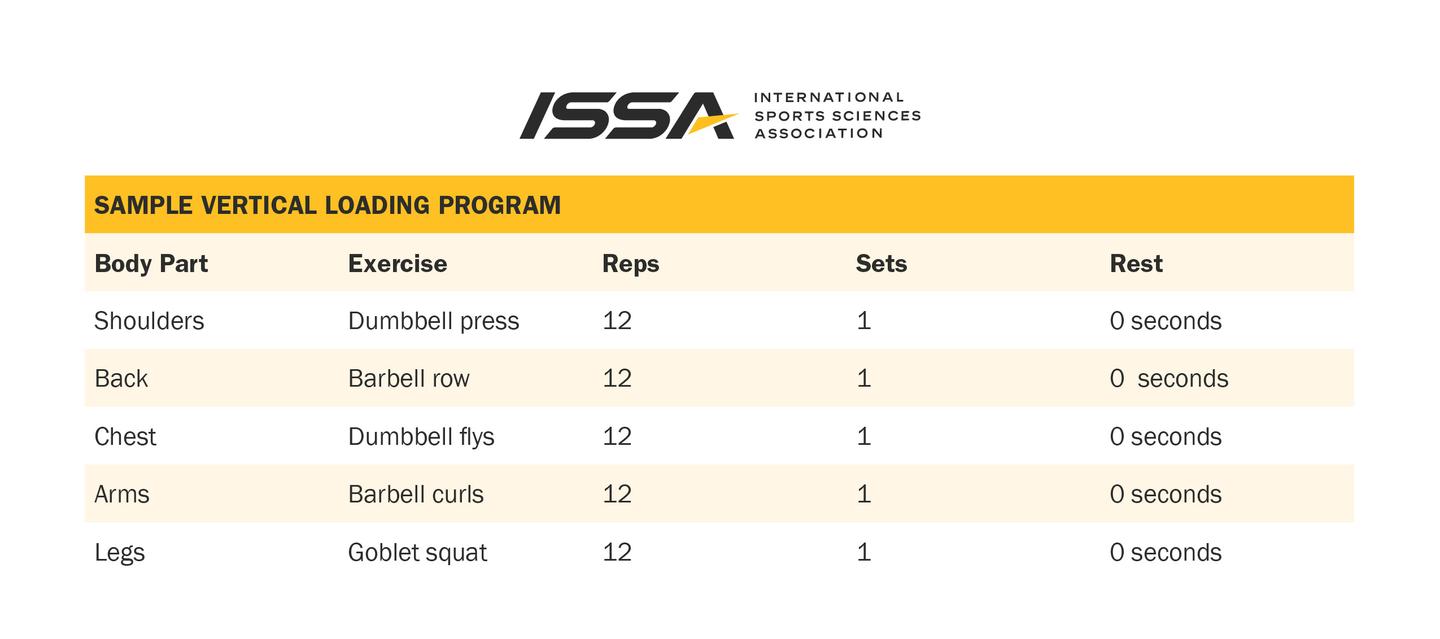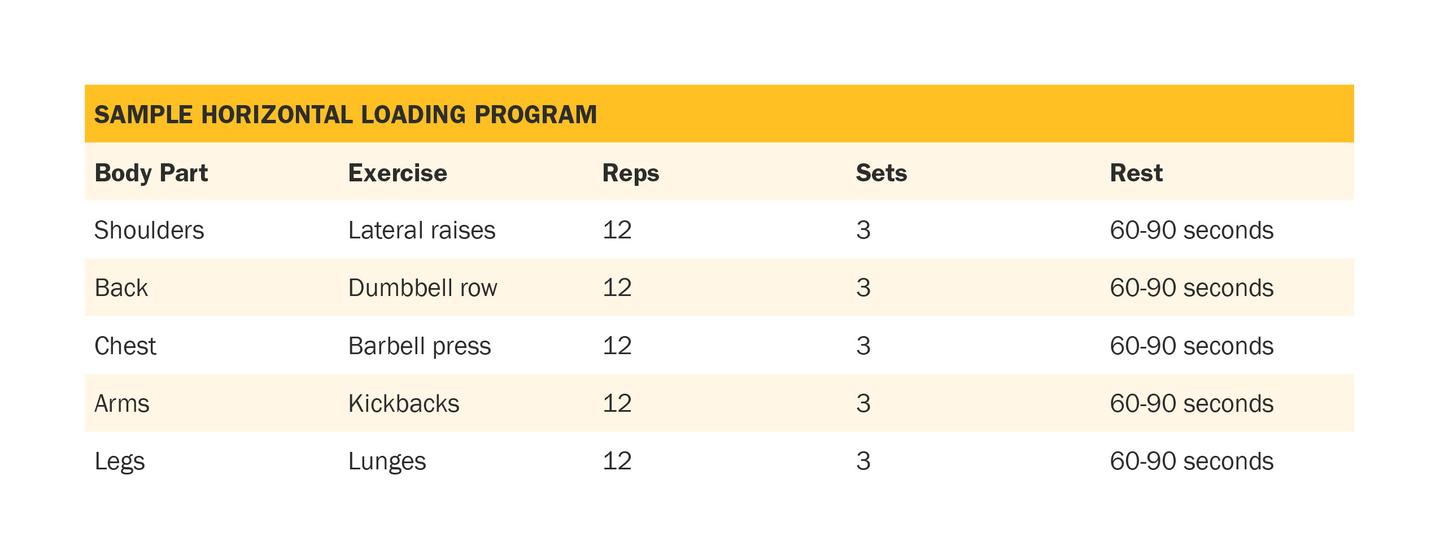
Vertical vs Horizontal Loading: What is Best for Your Goals?
Reading Time: 5 minutes 7 seconds
BY: ISSA
DATE: 2021-01-25
There are many different types of training, but all of them have one common goal. The purpose of training is to enable the human body to adapt and grow. All forms of training, including performance, strength, and circuit training must have structure. Proper program design allows trainers to scale client programs and help them achieve results.
As long as the exercise program maintains structure it can always be adjusted as a client progresses. Two popular ways to scale a client's training program is through vertical and horizontal loading. In this article, we discuss these two scaling systems and how they impact a client's exercise program.
What is Vertical Loading?
Vertical loading is when the first set of an exercise is followed immediately by the first set of another exercise. Clients will complete the second exercise before returning to the first exercise to begin set two. Vertical loading is often performed with more than two exercises so that clients can rest the previous muscle group used.
Clients perform vertical scaling by completing a sequence of exercises that work different muscle groups. This is similar to circuit training and short rest periods are used so clients can switch from exercise to exercise. The vertical scaling method starts with clients working a certain muscle group. Then moving vertically, up or down, on the body working the next muscle group.
If a client starts by targeting the chest in one exercise, they will immediately move on to work a different muscle, like the biceps or triceps. After that, the client continues to move vertically down the body eventually targeting the leg muscles. This circuit style training does not require long rest periods. As clients move through a series of exercises, they are giving the previously worked muscle group a rest.
This vertical sequence is good for recovery. Often no rest is needed at all, making this training style time effective. Short rest leads to a higher heart rate and provides cardiovascular benefits. Here are more tips to optimize workout recovery.
What is Horizontal Loading?
Contrary to vertical loading, horizontal loading is when all the sets of a given exercise are done before moving on to the next exercise. This type of scaling is a more common approach to exercise, especially in strength training.
Clients start by choosing one exercise and completing all the sets with rest in between each set. When the client completes 3 or 4 sets of a single exercise, they move on to the next exercise working a different muscle group. This method of training helps clients reach fatigue within one muscle group before moving to the next.
Horizontal scaling gives clients the freedom to adjust the load, rep scheme, tempo, and sets within an exercise. If a client's goal is to build muscle mass, then adjusting to a moderate volume and intensity is appropriate. If their goal is to build strength, then keeping the reps lower and the weight heavier is more beneficial.
Longer rest periods allow a client to perform better on their next set. This influences the client's results depending on their goal. Rest periods could be as long as 3 to 5 minutes. This is beneficial for some fitness goals. Longer rest periods help clients maximize their performance each set. Although it is not the most time-efficient training style.
Which Loading System is Best?
As a trainer, you must decide whether horizontal scaling or vertical scaling is best for your client. Both training methods produce results, but knowing which will work best for your client's goals is crucial. Whether clients are looking to lose weight, build muscle, increase strength, or improve endurance, you must choose the best style of training. This is not based only on their fitness goals, but also their lifestyle.
Burn Calories
If your client is looking to lose weight, vertical loading might be the best option for them. Vertical loading increases the intensity of the workout and maximizes calorie burn. Moving quickly from exercise to exercise keeps the heart rate elevated. The higher the heart rate, the more calories the body burns. In horizontal loading, a client's heart rate will not be as high. The longer rest periods and focusing on just one exercise at a time naturally leads to less calorie burn.
Time Efficiency
Clients who have a busy schedule can benefit from vertical loading. Circuit style training helps clients who are short on time complete their training in a timely manner. Check out these additional benefits of circuit training. Though clients still get the same amount of work in as a horizontal loading program, the rest periods between sets with horizontal loading adds a lot of time onto the total workout duration.
Breaking Plateaus
Horizontal loading is the more popular approach to training. Therefore, vertical loading can add variation to a client's training program. Most clients' bodies are used to performing one exercise before moving on to the next. This applies to those who are also used to vertical loading. Switching to a new training stimulus allows the body to continue growing and responding to the training stimulus.
Program Flexibility
Both training methods provide flexibility to adjust program components accordingly. This includes the actual exercises used to make up each workout, the order in which these exercises can be changed, along with the number of reps performed. Lastly, the tempo or speed of movement throughout each exercise or set also is adjustable to target a client's specific goals.
Putting it All Together
It is critical for clients to challenge their bodies in different ways. This helps them continue to grow and become stronger. Horizontal and vertical loading are two methods of training used in resistance training.
The horizontal loading method is more common when it comes to weight training or bodybuilding. Vertical training though is a great option for adding variety to a client's program. It helps break the traditional approach to weight training. This is important for avoiding plateaus and adapting to new goals.
Here are sample vertical loading and horizontal loading programs:


Are you looking to challenge and progress your clients even more? Prescribe a different loading method to prevent clients from becoming bored with their current program. The training approach that clients use can eventually become counterproductive. To increase effectiveness of a program, evaluate what clients have been doing and adjust to something new.
Are you ready to take the first step to help clients reach their fitness goals? Check out the ISSA's Certified Personal Trainer course. Learn how to provide clients with customized training programs based on their personal goals.